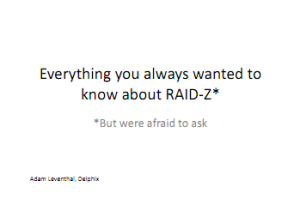This week it was my pleasure to welcome my former Sun colleague Matt Ahrens and George Wilson to Delphix. Matt and I studied computer science together at Brown and then joined Sun in 2001. Matt joined Jeff Bonwick to start ZFS while I worked on DTrace. George joined Sun in 1996, and worked in a variety of roles, joining the ZFS team in 2006 (just as I was leaving to help start Fishworks).
George and Matt bring an amazing knowledge of ZFS — the lower, and upper halves respectively — and are also just great engineers who are already contributing tangibly to the the success of Delphix. You can take a look at Matt’s old blog, or watch George in a bunch of videos (including one of him being interviewed by a muppet).
